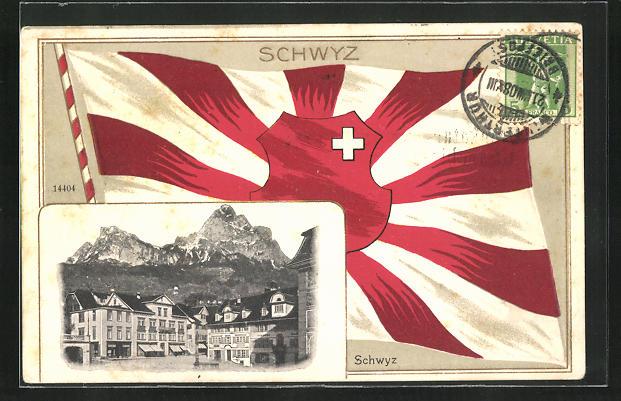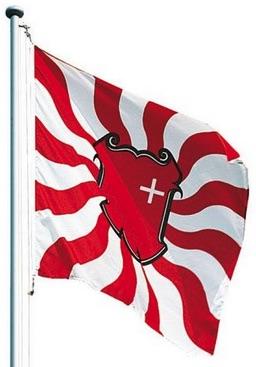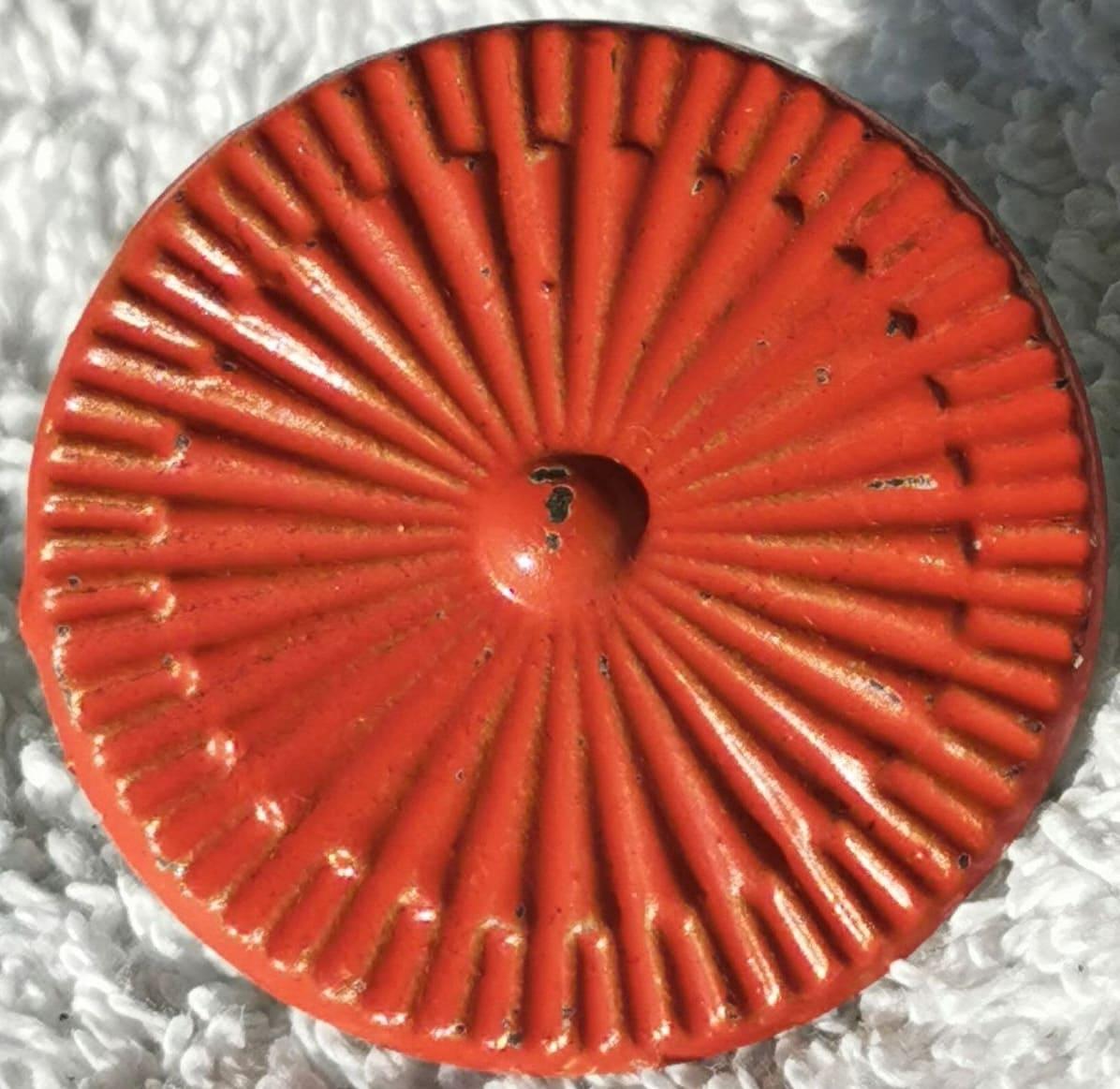 Flagge "Flagge des Kanton Schwyz" bei fahnenversand.de kaufen.
Flagge "Flagge des Kanton Schwyz" bei fahnenversand.de kaufen.
 Flagge "Flagge des Kanton Schwyz" bei fahnenversand.de kaufen.
Flagge "Flagge des Kanton Schwyz" bei fahnenversand.de kaufen.
Last modified: 2025-04-05 by martin karner
Keywords: switzerland | schwyz | german |
Links: FOTW homepage |
search |
disclaimer and copyright |
write us |
mirrors
![[Flag of Schwyz]](../images/c/ch-sz.gif) image by António Martins-Tuválkin
image by António Martins-Tuválkin
Description of the Flag
Gules, a Confederate Cross couped in the hoist argent.
On a red field, a small white cross with long narrow arms in the top
corner of the hoist.
T.F. Mills, 16 October 1997
T.F. Mills (writing in 1997) quoted a
Law of 1963 [see link above] which regulated the design and the relevant text reads as follows:
Decision of the Government Council on both the flag and arms effective 23
December 1963, Article One (1–3):
1. The arms of the cross of equal length
under itself are ever three times longer than broad.
2. The whole bar length
amounts to 1/3 of the horizontal side length of the flag or the coat of arms
sign.
3. The distance of flag or edge of coat of arms amounts to 1/3 of an
arm length.
My spec sheet shows a flag of 63 x 63 units with the cross
contained within an imaginary square of 21 units, this is set 3 units from the
top and hoist and is divided 9-3-9.
Christopher Southworth, 10 May 2007
![[Flag of Schwyz]](../images/c/ch-sz'.gif) image
by António Martins-Tuválkin
image
by António Martins-Tuválkin The figures
are as per Chris’ revised construction sheet, showing (1+3+1+3+13):(1+3+1+3+13)
= 21:21
António Martins-Tuválkin, 13 May 2007
History of the Flag
Emperor Friedrich II presented the blood-red war banner of the
empire to the warriors of Schwyz in 1240. Like the Uri banner, this
flag was granted as symbol of an "immediacy", i.e. sovereignty within
the Empire. For over 100 years it was plain red with no adornments.
Sometime in the 14th century, a depiction of the crucifixion
appeared in the first quarter. This was often a very complex image
(resembling a Russian icon) called the "Heilig Rych", including
representations of Christ, Mary and the apostle John. Pope Sixtus
IV confirmed this addition to the flag in 1480, augmenting it to
include specifically the crown of thorns and the nails. In 1512 the
12 members of the Confederation, plus three allies (St. Gallen,
Appenzell and Wallis) went to war on behalf of the Pope against the
French and liberated Milan. Pope Julius II conferred the title
"Defenders of the Liberty of the Church" on the Confederation, and
presented every Canton with an expensive damask cantonal banner with
an embroidered "Heilig Rych" in the first quarter (this time
depicting the coronation of Mary, the Queen of Heaven).
The first solid proof of the white cross appearing on the Schwyz war
banner dates from 1475. The original augmentation of a crucifix was
perhaps granted by Rudolf in 1289 for services rendered in his war
against Bohemia. In 1291, Schwyz joined its neighbours Uri and
Unterwalden in the original Swiss confederation. The long-armed
cross of Schwyz later became the insignia of the Confederation,
appearing on warriors' tunics and their thighs, and on long red
pennons attached to some cantonal war banners. All depictions of the
Passion on the Schwyz flag were eliminated in 1815 and reduced to the
simple white cross.
T.F. Mills, 16 October 1997
The flag was originally a battle flag, red in color, flying at battles of
Morgarten (1315), Laupen (1339 and Sempach (1386). In the 14th century, the
cross was introduced appearing in the hoist quarter, sometimes accompanied by
the figures of Mary and Joseph. There are two major legends regarding the
addition of the cross, one that it was cut from a missal given to Count Rudo.
Source: Angst (1992), "A Panoply of
Colours: The Cantonal Banners of Switzerland and the Swiss National Flag"
Phil Nelson, 14 October 1998
A few other sources give images of the actual Schwyz flag:
https://de.wikipedia.org/wiki/Fahne_und_Wappen_des_Kantons_und_der_Gemeinde_Schwyz
(with Google Translate)
"The banner of Canton Schwyz has been a rectangular red silk cloth since the later 13th century. [...]
The evidence is that the Schwyz banner has had a corner image (Zwickelbild) since the 14th century, even though the
oldest surviving example dates from after the Burgundian Wars (symbolic picture).
This corner district is mentioned in
writing by Conrad Justinger and in the Bern city chronicle (both around 1420). It is depicted in the
drawing of the Battle of Morgarten in the Tschachtlan Chronicle (around 1470). Schwyz received a banner
privilege from Pope Sixtus IV in 1479, which gave the right to depict the crucifixion scene in the corner
quarter.
The depiction of the crucifixion of Christ in the corner quarter of the Schwyz banner is referred to as
'heilig Rych' (holy kingdom), for the first time in the Bern city chronicle of 1420. In 19th-century
historiography it was assumed that the red banner had been awarded to Schwyz in 1240 by Emperor Friedrich
II near Faenza, and the existing banner was augmented by Rudolf von Habsburg in 1289 with the 'holy Rych'.
The Schwyz Juliusbanner of 1512 has a fully worked out Crucifixion scene in the corner quarter."
(File: Schwyz Banner 14th and 15th c.: commons.wikimedia.org).
And about the form of the cross motif over time:
https://www.fahnenwelt.ch/geschichte.htm
(with Google Translate)
"The oldest surviving Schwyz flag, simply red without any symbols, was carried at the Battle of
Morgarten in 1315! A little later, but at the latest in the last third of the 15th century, a small
religious image was attached to this red flag on the upper side of the pole. Such signs are also called
corner quarters or spandrels. The oldest surviving corner district of Schwyz consists of a piece of
painted leather sewn onto a red flag that can be proven to have been carried during the Burgundian wars of
1474–1477. This corner quarter shows Jesus crucified with the instruments of torture, a motif called
the Arma Christi. The Swiss pictorial chronicles of the 15th century sometimes show a sketchy form of this
corner quarter with a simple cross and two small dashes, a motif which is also called Heilig Rych, but
actually has the same origin. This picture shows a creation based
on these old Schwyz flags in a simplified form. A status disc from 1501 shows the red Schwyz banner with
black corner quarters and a golden cross with instruments of torture. In 1512, Pope Julius II presented
the Confederates and their allies with precious flags, the so-called Julius Banners, out of gratitude for
their military help: The one from the state of Schwyz has been preserved and has a black corner quarter
with the crucified Christ and the instruments of torture as well as the papal keys in gold. As a basis for
the design of the old Schwyz flag, the color pattern of the state disc and that of this famous banner were
used (picture).
In the course of the 17th century, a continuous white cross was added to the red flags with corner
quarters, in the 18th century these were then replaced by red and white flamed flags with a continuous
cross, and for the first time in 1792 a red Schwyz military flag was used with a white little cross in the
upper corner [see picture below, Officer Designate]. In 1815, the red coat of arms of the canton of Schwyz was provided with
a small white cross in its upper left corner.
Canton of Schwyz gave Switzerland its name, the red color
of its flag also influenced the national flag, but the cross in the national flag does not come from
the Schwyz flag."
Ben Cahoon, 31 July 2023
It is important to distinguish between the corner field (Zwickelbild, Heilig Rych = holy kingdom)
with the Biblical scenes and the white cross. The oldest existing Zwickelbild dates from the
Burgundian Wars (1474–1477, see picture below at "Miscellaneous Pictures"). There exists a plain red banner from the battle of Laupen (1339) which
shows stitched seams in the corner field which indicates that there must have been a corner field which
has been removed.
One of the earliest examples of the little white cross is a window pane from 1579 which shows the cross
on the coat of arms. Since the 17th century the CoA was increasingly depicted with the white cross.
On the flags the white cross appeared not before the end of the 18th century in individual cases
(see picture below, Officer Designate). Only after the government of Schwyz defined the coat of arms in
1815 (with the white cross), the little cross appeared regularly on the flags. The proportions of the
cross were defined not before 1963 (see above, Description of the flag).
Martin Karner, 31 July 2023
– Banner of Schwyz, carried at the battle of Morgarten (1315) (source)
– Banner of Schwyz, carried at the battle of Sempach (1386) (source: [b7b42]).
– Banner of Schwyz, carried during the Burgundian Wars (1474–77), Zwickelbild (source).
– Julius Banner (1512), dedicated from pope Julius II to Schwyz for their
support in the Pavia campaign. Inscription (Latin): "The Blessed
Mother, her scion and the keys were given to them [the people of Schwyz] because they had been defenders
of the Holy Mother, the Church. In the year of the Incarnation 1512, under the reign of [pope] Julius II"
(source).
– Stained glass plate from 1573 with banner, coats of arms and the imperial double eagle as a sign of imperial
immediacy. The little cross on the CoA appeared generally in the 17th c. On the top biblical scenes with Moses
parting the sea and Pharao's army drowning in the waters (source).
– Banner of Schwyz, carried during the so-called "Swedish War"
in 1634. This was one of a few incidents when Switzerland was affected by the Thirty Years' War (1618–48).
The prince-abbot of St. Gallen had called on the five Catholic cantons of central Switzerland for help, since
Swedish troops under General Horn had crossed the Rhine at Stein am Rhein and invaded Thurgau (to attack
the city of Constance from the south). The banner shows
in its corner field St. Martin, the patron-saint of Schwyz, on the obverse (not visible here), and Mary with
little Jesus and St. Catherine on the reverse. This is a rare case of a corner field (Zwickelbild) being
a copy of a painting. The original image is the altar painting of the Niederöst chapel in
Oberschönenbuch (Ibach SZ) (source: [b7b42]).
– Regimental Flag of Schwyz (18th c., 230x250 cm). Used in 1792 during the defensive operations at Basel against
the French invasion (source).
– Officer Designate (flagbearer) of Schwyz (end of 18th c.). An early example of the flag with the white cross in the canton (source).
– Painting with coat of arms and allegories of justice, unity and
prosperity (1st half 19th c., probably 1833 at the renewal of the cantonal constitution), by Michael
Föhn, oil on canvas, 62x68 cm. Location: State Archive,
Schwyz (source). Around 1830 Schwyz
(as other parts of Switzerland) went through bigger turmoils between liberal and conservative forces. The
outer districts towards Lake Zurich (Ausserschwyz [Vorderer Hof, March,
Einsiedeln]), together with the Küssnacht
district, seceded by forming the new half-canton Ausserschwyz,
which lasted from 1831 to 1833 (flag, source).
![[Colour Flag SZ]](../images/c/ch-sz_col.jpg) image
located by Martin Karner
image
located by Martin Karner
Rectangular cantonal flag, as shown in Mader (1942) (So-called
colour flag [Farbenfahne in German].
Since the cantonal colour is plain red, the colour flag
could be plain red as well, writes Mader. But because there could be confusion with political or other red
flags, the white cross is usually added).
Martin Karner
See also: STATE COLOURS in Dictionary of Vexillology
Flaggen, Knatterfahnen and Livery Colours |
![[Knatterfahnen]](../images/c/ch-sz_kf.gif)
|
Flaggen are vertically hoisted from a crossbar in the manner of gonfanon, in ratio of about 2:9, with a swallowtail that indents about 2 units. The chief, or hoist (square part) usually incorporates the design from the coat of arms – not from the flag. The fly part is always divided lengthwise, usually in a bicolour, triband or tricolour pattern (except Schwyz which is monocolour, and Glarus which has four stripes of unequal width). The colours chosen for the fly end are usually the main colours of the coat of arms, but the choice is not always straight forward.
Knatterfahnen are similar to Flaggen, but hoisted from the long side and have no swallow tail. They normally show the national, cantonal or communal flag in their chiefs.
Željko Heimer, 16 July 2000
For Schwyz this type of flag adopts the position of the cross in the upper left corner as it is on the
coat of arms, and therefore appears there in the Flaggen. For the Knatterfahnen,
we are talking about vexillology and not heraldry, the cross is of course in the upper right corner.
The livery colours also retain the little white cross (located on the left corner like the flag), this is to avoid confusion with any political banner.
Pascal Gross, 17/23 April 2001
See also: HANGING FLAG, VERTICALLY HOISTED FLAG, LIVERY COLOURS in Dictionary of Vexillology
![[Shield of Schwyz]](../images/c/ch-sz).gif) image
by António Martins-Tuválkin
image
by António Martins-Tuválkin
The coat of arms of Schwyz. Like Ticino
and Zürich, Schwyz does not use, for historical
reasons, an exact banner of
its arms.
António Martins-Tuválkin, 16 June 2007
The full text of the Government decision of the size of the cross and coat of arms:
Government council decision over the definition of the size of the cross in the coat of arms of the Swiss federal conditions Schwyz 1 (from 23 December 1963) the government advice of the canton Schwyz, in consideration that in the Schwyz canton coats of arms were not uniformly certain the mass of the cross and in the canton flag so far, decides:Christopher Southworth, 16 June 2007
I. For the cross in the coat of arms of the Swiss federal conditions Schwyz following proportions and mass are specified:
1. The arms of the cross of equal length under itself are ever three times longer than broad.
2. The whole bar length amounts to 1/3 of the horizontal side length of the flag or the coat of arms sign.
3. The distance of flag or edge of coat of arms amounts to 1/3 of an arm length.
II. With all new preparations of kantonaler prints and flags of the canton administration are to be kept the managing mass.
III. This resolution is taken up to the law collection.

 images located by Martin Karner
images located by Martin KarnerAt the beginning of the 20th century, flamed flags were still in use, with the white cross replaced by
a (baroque) shield in the centre of the flag. These decorative flags had been used until WWII and then
somewhat forgotten in preference of the current cantonal flags. [Today they are being
produced again, see right image]
Pascal Gross, 30 June 2002
See also:
logo.jpg) image located by Martin Karner (8 May 2024)
image located by Martin Karner (8 May 2024)logo_old.jpg) image located by Martin Karner (8 May 2024)
image located by Martin Karner (8 May 2024) image located by Martin Karner
image located by Martin KarnerCockade for the cantonal troops' headgear (regulation from 1898, size: ca. 35 mm, reverse side).
Martin Karner, 14 March 2025
See also: Cockades (Swiss Army)







